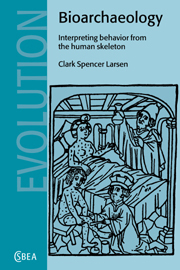Book contents
- Frontmatter
- Contents
- Acknowledgments
- 1 Introduction
- 2 Stress and deprivation during the years of growth and development and adulthood
- 3 Exposure to infectious pathogens
- 4 Injury and violent death
- 5 Activity patterns: 1. Articular and muscular modifications
- 6 Activity patterns: 2. Structural adaptation
- 7 Masticatory and nonmasticatory functions: craniofacial adaptation
- 8 Isotopic and elemental signatures of diet and nutrition
- 9 Historical dimensions of skeletal variation: tracing genetic relationships
- 10 Changes and challenges in bioarchaeology
- References
- General index
- Site index
10 - Changes and challenges in bioarchaeology
Published online by Cambridge University Press: 05 June 2012
- Frontmatter
- Contents
- Acknowledgments
- 1 Introduction
- 2 Stress and deprivation during the years of growth and development and adulthood
- 3 Exposure to infectious pathogens
- 4 Injury and violent death
- 5 Activity patterns: 1. Articular and muscular modifications
- 6 Activity patterns: 2. Structural adaptation
- 7 Masticatory and nonmasticatory functions: craniofacial adaptation
- 8 Isotopic and elemental signatures of diet and nutrition
- 9 Historical dimensions of skeletal variation: tracing genetic relationships
- 10 Changes and challenges in bioarchaeology
- References
- General index
- Site index
Summary
Introduction
Reflecting back over a half-century of research, Armelagos, Carlson, & Van Gerven lamented that ‘human osteology has been and continues to be dominated by an overriding concern for the description of biological differences between populations, the result of which has been an evergrowing number of taxonomic definitions’ (1982:310). They advocated an overhaul of the field – involving an overall reorientation from description to process – in order to better understand the underlying biological significance of human skeletal variation. Although they primarily addressed issues relating to skeletal morphology and the relationship between form and function, their proposed paradigmatic shift can be more broadly applied to the study of most other aspects of past humans remains discussed in the foregoing chapters of this book.
In many ways, there has been a shift in bioarchaeology. This change has been facilitated by a number of important technological, methodological, and theoretical advances. To be sure, some of these advancements – for example, the growing sophistication of high-speed computers and computing – may have only fueled the fire for multivariate studies and increased elaboration of taxonomy and description (see Armelagos et al., 1982; Larsen, 1987). On a more positive note, the revolution in computing brought about by the wide availability of powerful desktop computers has greatly enhanced our proficiency in analyzing complex problems in a more comprehensive fashion than was possible a decade or so ago.
- Type
- Chapter
- Information
- BioarchaeologyInterpreting Behavior from the Human Skeleton, pp. 333 - 342Publisher: Cambridge University PressPrint publication year: 1997
- 1
- Cited by



